
![]()
~ THE MILLS ~
CANTERBURY
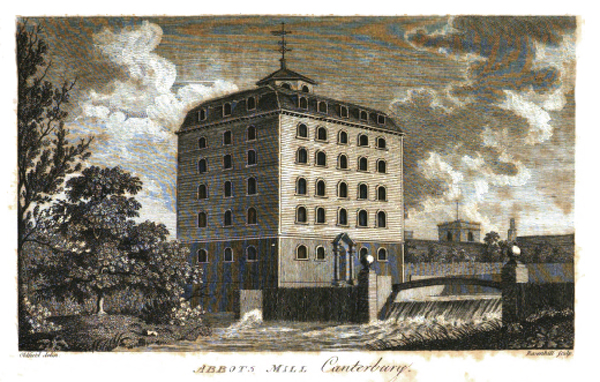
Abbots Mill
The Abbotts mill from an old map in my collection
There is nothing to say further of this river, excepting as to the Mills situated on it in and about this city, which are now but few, in number only five; whereas about king Stephen's time, I find that, besides these mills, there were six others standing upon this river, in or not far from this city, which belonged to the monks of Christ Church; all which are long since down and quite gone.
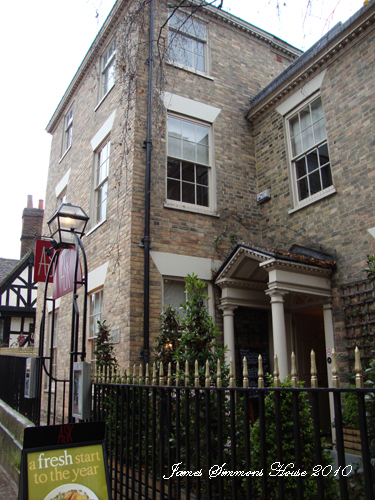
Site of Kings Mill
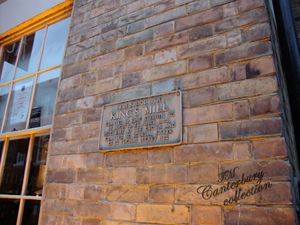
HERE STOOD THE
KING'S MILL
GRANTED BY KING STEPHEN TO
ST. AUGUSTINE'S ABBEY 1144,
RECOVERED BY THE CROWN AND
GRANTED TO ROHESIA, SISTER
OF ST. THOMAS BECKET 1174
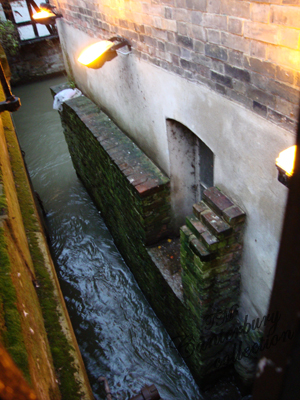 ___
___
The five mills above-mentioned still remaining, are King's-mill, so called, because it formerly belonged to the king, and was otherwise called both Eastbridge mill, and Kingsbridge mill, from the near situation to that bridge. Thorn, in his chronicle, says, that king Stephen gave to the abbot of St. Augustine, the mill which he had within the city near Eastbridge, with the course of water belonging to it, in recompence for one hundred marcs, which he received from that church in his necessity; from which time the abbots enjoyed the mill, until abbot Clarembald made it over to king Henry II. who in lieu of it granted many liberties to the monastery. Afterwards, when the city was granted to the citizens in see farm, by Henry III. this mill of Eastbridge, otherwise called King's-mill, as parcel, was expressly included in the grant and given to the citizens, together with the borough, and they posses it at this time.
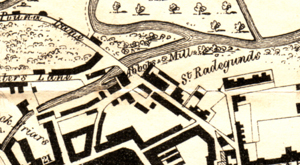
"Abbot's Mill" map detail above from Felix Summerly 1843
Feb 22 1647 - William Gillam, Miller regarding lease of King's Mill CCA
June 3, 1656 - William Gillam, concerning lease of a mill CCA
1852 - Poll for the Knights of the shire - List of persons who have claimed and are registered to vote in the Maidstone District in which their places of abode are situate, or who are not resident in the County of Kent - William CANNON, Abbott's Mill, Canterbury
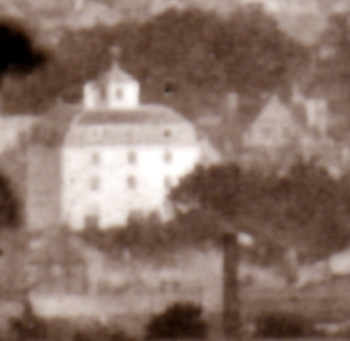
"Abbot's Mill"
Abbot's mill, the next upon the same stream, below King's-mill, was so called because it once belonged to the abbot of St. Augustine, and that as early as king Stephen's reign, being then purchased by the abbot Hugh, the second of that name, at his own cost, for the use of the facility of his monastery. At the suppression of the monastery, in the 30th year of king Henry VIII. this mill came into the king's hands.
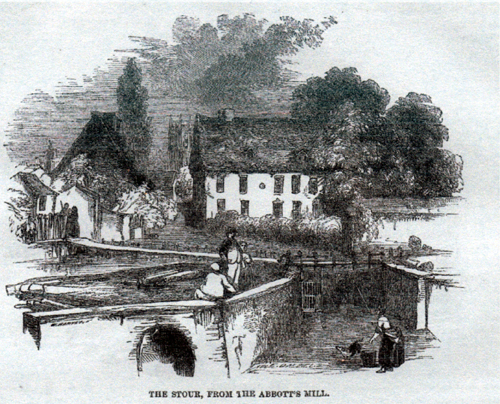
It now belongs to the mayor and citizens of Canterbury. For many years this mill, from the occupier of it was known by the name of Brown's mill; but Mess. Simmons and Royle having in 1791 obtained the lease of it from the corporation*, restored its ancient name of Abbot's Mill. They have since erected, at the expense of near 8000l. a capital building and corn mill, on the ancient cite, from plans furnished by the late ingenious Mr. John Smeaton, which is of such curious and strong mechanical powers, as to be able to grind and ress from 500 to 700 quarters of corn weekly. Mr. Simmons is now the sole lessee of it. **
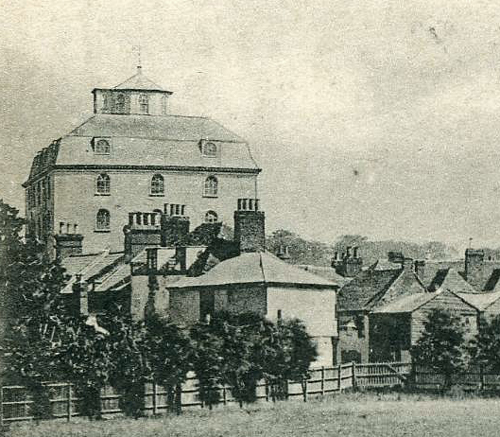
A detail from a Goulden Postcard of Canterbury from North Lane showing a beautiful view of Abbot's Mill. Thanks to Len Parrick for this lovely postcard
Westgate mill, the first upon the other stream is a very antient one; in the survey of Domesday, it is mentioned as being the archbishop's mill, but then in the hands of the canons of St. Gregories. The tithe of it was by archbishop Hubert, in king John's time granted, among other things, to the hospital of Eastbridge, and that grant was confirmed by the prior and convent of Christ-church. This mill still continues parcel of the demesnes of the archbishop of Canterbury.

Showing Abbots mill on the right just in front of the Cathedral
Shafford's mill, now called Dean's mill, from the late possessor of it; is situated on the same stream, at no long distance below Westgate itself. Mr. Somner thinks it is the same, which about king Richard I's time, was called Scepeshotesmelne; in the 20th year of king Edward III. it was called by the name of Shafford's mill. It is now the property of Mr. Deane John Parker.
The mill was rebuilt c. 1790 and bought by William Hooker in the 1890's. Also know as Hookers Mill, re-named Westgate Mill, burnt down June 1954.
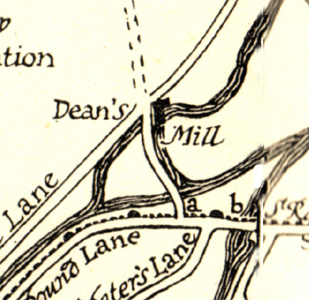
Map detail showing Dean's Mill, from "Canterbury, A history of the Ancient City"
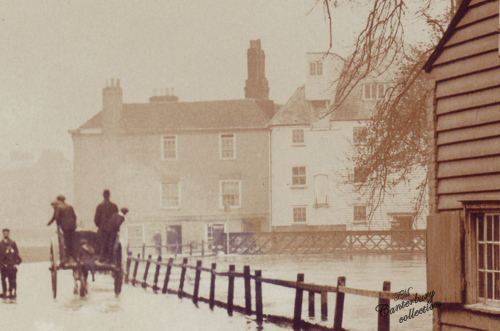
Hooker's Mill (Dean's Mill) The Causeway, Canterbury (a detail from a photo in my collection Oct 30, 1909)
The mill once owned by Sidney Cooper, Burnt down June 6, 1954
Barton mill is situated still further down the river, and appears by some of the buildings belonging to it, made of flint with ashlar windows and quions, to be of good antiquity. It formerly belonged to the priory of Christ church being appropriated to the grinding of the corn used by them for their own spending within the court. At the dissolution in king Henry VIII's time, it came to the crown. Christopher Hales, esq. afterwards knighted, and attorney-general to king Henry VIII. was possessed of this mill, then called Barton mill, with a meadow belonging to it, then in the tenure of George Robinson, holding it in capite by knight's service, and then being of the value of ten pounds. He died in the 33d year of that reign, and it was afterwards sold by his daughters and coheirs to Thomas Culpeper, on whose decease, Alexander his son, had livery of it in the 3d and 4th year of Philip and Mary. It lately belonged to Mr. Allen Grebell, who erected close to it a handsome house, in which he afterwards resided. But the mill and some land adjoining to it, has been lately sold to Messrs. Sampson* and William Kingsford, the latter of whom has long resided on the premises. HT
*March 22, 1808 - About six this evening, an alarming fire broke out in the newly-erected flour mill, at Sturry, near Canterbury, belonging to Mr. Sampson Kingsford, which, from the wind being high, and the nature of the materials of which it was constructed, burnt so rapidly, that in the space of three hours it was wholly destroyed together with a large quantity of wheat and flour.
Whereas a Fiat in Bankruptcy is awarded and issued forth against John KINGSFORD, of Barton-Mill, in the parish of St. Mary, Northgate, in the City of Canterbury, Miller, and he being declared a Barnkrupt is hereby required to surrender himself to the Commissioners in the said Fiat named, or the major part of them, on the 13th day of November next, at Twelve at noon precisely, on the 14th of the same month, and on the 10th day of December following, at Eleven in the Forenoon, at the Guildhall, Canterbury, and make a full discovery and disclosure of his estate and effecst, when and where the Creditors are to come prepared to prove their debts, and at the first sitting to choose Assigness, and at the last sitting the said Bankrupt is required to finish his examination and the Creditors are to assent to or dissent from the allowance of his certificate. All persons indebted to the said Bankrupt, or that have any of his effects, are not to pay or deliver the same but to whom the Commissioners shall appoint, but give notice to Messrs. Curteis and Kingsford, Attorneys at Law, Canterbury, or to Messrs. Egan and Waterman, 25 Essex Street, Strand London. The London Gazette, Part 2 1833
Another fire at Bartons Mill August 17 1951
"Farther on, and within the city liberty, is Barton Mill, on the river a little way from the road. Some remains of flint walls by the way-side thither, and a chapel near the mill, pretty entire, seem to show there was once a considerable enclosure; but neither the Canterbury antiquarians, nor common tradition, give any history of it." W.G.
John Brent - Abbot's Mill
Thomas Kingsford - Barton Mill
Deane John Parker - Deane's Mill
1824D
The mills on the Stour near Canterbury are of very ancient date and chiefly belonged to the ancient religious establishments in this city; those at present existing are, the Kyngesmelle, or Kingsmill at Eastbridge; Westgate Mill; Abbot's Mill; Dean's Mill, called in 1189 Shepeshote's Meln, and afterwards Shafford's Mill; and Barton Mill on the Sturry Road; besides these others have been more subsequently erected in various parts of the stream. Directory 1838
"It has created mills in number on its banks, some of which have been recorded in history since William the Conquerer's survey: they appear to have been much more numerous formerly than at present. Somner mentions King's mill, Abbot's mill, Westgate mill, Shafford's mill, (in 1189 called Schepeshotesmeln - now called Dean's mill) and Barton's mill, as standing in his time; and he also speaks of seven others, by name, as existing in King Stephen's reign. King's-bridge was also called East-bridge mill, and King Stephen sold the same to the Abbot of St. Augustine's to raise a hundred marks for his ransom, when captured by one of his barons, the Earl of Gloucester. What an impossible thing at the present day, that Queen Victoria should be locked up a prisoner by Lord Brougham, and pledge the Green Park to Mr. Rothschild, to pay for her release! So that, whether we like it or not, the proverb "Tempora mutantur" will continue to apply. The localities of the existing mills will be found indicated in the plan: they are called Dean's mill, Barton's mill, East mill and Abbot's mill. It is likely enough that Chaucer drew his portrait of his miller from a specimin in Canterbury:
"The Miller was a stout carle for the nones,
Full bigg he was of braune, and eke of bones,
That proved well, for over all there he came,
At wrastling he would have away the Ram.
He was short shuldred, a thick gnarre,
There was no doore, but he would heve the bar,
Or breake it with the renning of his hedde,
His beard as any sowe or forre was redde,
And thereto brode, as it were a spade,
Upon the coppe right of his nose he hade
A werte, and thereon stode a tufte of heeres,
Redde as the bristles of a sowe's eares;
His nostrels blacke were and wide.
A sword and buckeler bare he by his side;
His mouth as great was as a furneis,
He was a jangler and a golierdeis,
And that was most of sinne, and harletrise;
Well couth he steale corne and toll it thrise,
And yet he had a thombe of gold parde,
A white coate and a blew hode weared he.
A bagpipe well couth he blow and soune,
And therewithall brought he us out of toune."
In 1536, the corporation kept several swans on the Stour, and a person was employed with a yearly salary to look at them." (Bunce's Minutes.) But no such ornamental appendages to this river are to be seen at present. There are several BRIDGES over the Stour in Canterbury, of one kind or another. Carriages can pass over Westgate and King's or Eastbridge, and over that at the back of East Mill, rebuilt not many years since, but not over the others, which are mere foot-roads."
FS1843

The site of Abbot's Mill looking towards the Dominican Priory
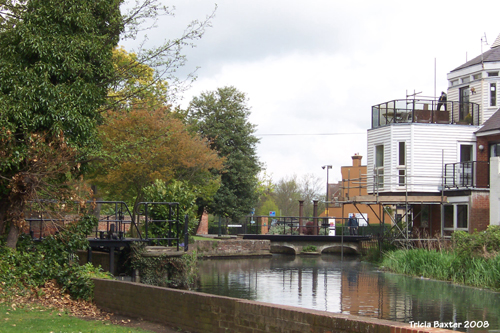
The site of Abbot's Mill looking from Solly's Orchard
"There are several extensive corn mills on the river Stour, some of which have been recorded in history since the time of William the Conqueror; they appear to have been much more numerous formerly than at present. Somner mentions five as standing in his time, and he also speaks of seven others, by name, as existing in the time of King Stephen, six of which belonged to the monks of Christ Church. Abbot's mill was so called because it once belonged to the Abbot of St. Augustine, being purchased in King Stephen's reign by Abbot Hugh, at his own cost, for the use of the sacristy of his own monastery. It is now the property of the Corporation, and held in lease by Mr. William Cannon. The present mill, a noble structure of wood, was erected at a cost of 8,000 pounds, about half a century ago, and is capable of grinding and dressing from 500 to 700 quarters of corn weekly. Barton mill formerly belonged to the priory of Christ Church. There is also Dean's mill and East mill on the Stour, with several windmills on the neighbouring hills."
1847D

"Barton Mills" detail
The King's Mill on East Bridge is taken down by Mr. Simmons 1800
The Abbot's Mill built in 1792 was destroyed by fire in 1933
Barton Mill was partially destroyed by a fire in 1951
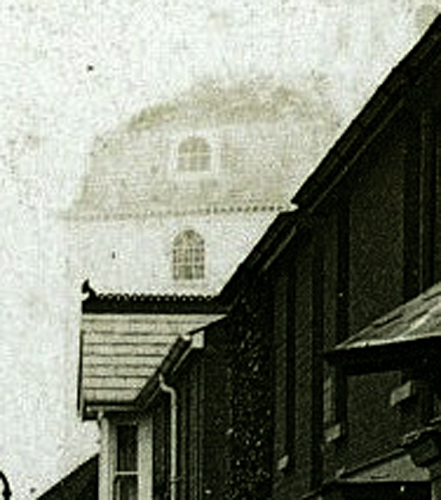
A detail of Abbot's Mill from a photo of the flooding in October 1909, the photo courtesy of michaelsbookshop.com
The next public work engaged in, by him, was the erection of a mill on a magnificent scale, for the regular supply of the Canterbury market with flour. In 1791, Messrs. Simmons and Royle gave a premium of 2450l for a thirty years' lease of Abbot's and King's mill, and they expended on the building and other improvements to the amount of 8000l. more. Mr. Smeaton, the late celebrated engineer, while engaged at Ramsgate harbour, undertook the erection of a new mill, with such a power as to be able to turn six, and even eight pair of stones. When spoken to by Mr. Simmons, and asked if he would undertake it, he replied in the affirmative, adding at the same time with a smile, "Yes, I consent to your request, and I am the only man in England, who can complete your project; for I have been occupied all my life about water, and think I can make a drop of it go further than any other man in the kingdom." Instead of converting this project, which was finished by Mr. Abbot, of Canterbury, in a very masterly manner, into a monopoly for the oppression of the inhabitants, and the creation of an immense fortune, Mr. Simmons was enabled to realize those projects dearest to his heart. It was capacious enough for the ambition of any man, or the execution of a scheme, as it forms a quadrangle of 72 feet, by 52, 5 inches; the height from the foundation to the vane is about 100 feet, and it contains six working floors, besides the observatory on the top, in which Mr. Simmons was accustomed, at times, to give entertainment's to public bodies, such as the chief officers of the district &c. As the returns have been computed at 40,000l per annum, he was enabled to keep down the price of meal, and the assize of bread.
The following is an account of this ingenious contrivance: - "To the grinding floor the walls are substantially built of brick and stone; from thence to the eaves, the building is continued with rueffy timber, covered with plain weather-boarding, terminating on the four sides, handsomely and uniformly sashed, with a bold block cornice, and the whole roof covered with slates. The wheel thoroughs are accurately curved, and lined with jointed Portland stone. The four water wheels, which put the whole machinery in motion, are sixteen feet diameter, and seven feet wide. the four wheels, whose nuts, arms, and shafts, are iron, carry eight pair of stones. From the four wheels, by a continuation of upright iron shafts, motion is given to the complicated machinery for clearing the corn, dressing the flour and lastly to the lifting tackle upon the upper floor. The mill-works, which are distinct for each water wheel, are of iron, where it would be properly substituted for wood, and the whole finished with a mechanical accuracy, so much to the credit of the several artists employed in their construction, that though the greatest fall of water here never exceeds five feet three inches, this mill is so powerful, as to be capable of grinding and dressing into flour 500 quarters of corn weekly.
"There the vast mill-stone with inebriate whirl, On trembling floors his forceful fingers twirl; Whose flinty teeth the golden harvests grind, Feast without blood! and nourish human kind."
The bridge over the mill stream, the adjoining swinery, spacious lodges and stabling, and a spacious shop for retailing meal and flour in small quantities, besides a number of dwellings in Brown's land, and King's street, are additional and recent improvements by Mr. Alderman Simmons, now the sole lessee of Abbot's Mill." Gostling's Walk
The Gentlemen's Magazine 1808

"Abbot's Mill"
Without the garden in a meadow adjoining the "Abbot's Mill," which belonged to St. Augustine's Monastery, are 5 large poplars (1 Canescens, British, and 4 Monilifera, Canadian). They are about 100 years old, and so picturesque with their ribbed trunks, and great masses of pointed leafage, as to be well worth the artists attention.
A handbook for Travellers in Kent and Sussex 1858
1515. A dyker is paid for making a dam, and turning the stream, at the end of the town-wall, by St. Mildred's church, for making of the King's mills. HT
*Abbot's Mill was bought by the Corporation in 1543
There was a Cock Mills near Westgate noted on the map in Felix Summerly's book in 1843, there is a drawing of West Gate, Canterbury, 1784 showing a mill near it.
Westgate Mill
© T. Machado 2013